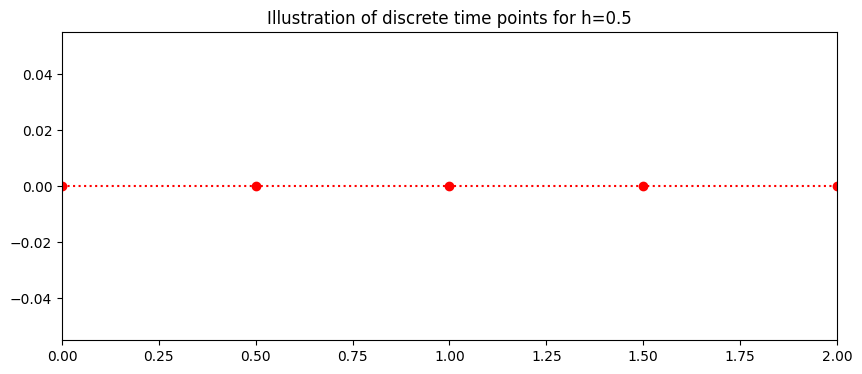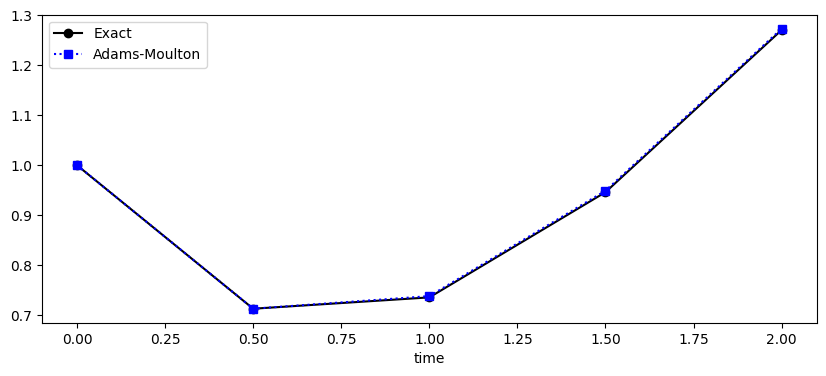Adams Moulton#
John S Butler#
john.s.butler@tudublin.ie
Course Notes Github
The Adams Moulton method is an implicit multistep method. This notebook illustrates the 2 step Adams Moulton method for a linear initial value problem of the form
with the initial condition
The video below walks through the notebook.
from IPython.display import HTML
HTML('<iframe width="560" height="315" src="https://www.youtube.com/embed/L1IrVMykC6k" frameborder="0" allow="accelerometer; autoplay; clipboard-write; encrypted-media; gyroscope; picture-in-picture" allowfullscreen></iframe>')
/Users/johnbutler/opt/anaconda3/lib/python3.8/site-packages/IPython/core/display.py:724: UserWarning: Consider using IPython.display.IFrame instead
warnings.warn("Consider using IPython.display.IFrame instead")
Python Libraries#
import numpy as np
import math
import pandas as pd
%matplotlib inline
import matplotlib.pyplot as plt # side-stepping mpl backend
import matplotlib.gridspec as gridspec # subplots
import warnings
Defining the function#
def myfun_ty(t,y):
return t-y
Discrete Interval#
Defining the step size \(h\) from the interval range \(a\leq t \leq b\) and number of steps \(N\)
This gives the discrete time steps,
where \(t_0=a.\)
Here the interval is \(0≤t≤2\) and number of step 4
This gives the discrete time steps,
for \(i=0,1,⋯,4.\)
# Start and end of interval
b=2
a=0
# Step size
N=4
h=(b-a)/(N)
t=np.arange(a,b+h,h)
fig = plt.figure(figsize=(10,4))
plt.plot(t,0*t,'o:',color='red')
plt.xlim((0,2))
plt.title('Illustration of discrete time points for h=%s'%(h))
Text(0.5, 1.0, 'Illustration of discrete time points for h=0.5')

Exact Solution#
The initial value problem has the exact solution
The figure below plots the exact solution.
IC=1 # Intial condtion
y=(IC+1)*np.exp(-t)+t-1
fig = plt.figure(figsize=(6,4))
plt.plot(t,y,'o-',color='black')
plt.title('Exact Solution ')
plt.xlabel('time')
Text(0.5, 0, 'time')

2-step Adams Moulton#
The general 2-step Adams Moulton difference equation is
For the specific intial value problem the 2-step Adams Moiulton difference equation is
for \(i=0\) the difference equation is:
this is not solvable as \(w_{1}, \ w_{-1}\) are unknown. for \(i=1\) the difference equation is:
this is not solvable as \(w_{1}\) and \(w_{2}\) are unknown. \(w_1\) can be approximated using a one step method. Here, as the exact solution is known,
As the intial value problem is linear the difference equation can be rearranged such that \(w_2\) is on the right hand side:
### Initial conditions
w=np.zeros(len(t))
w[0]=IC
w[1]=y[1] # NEEDED FOR THE METHOD
Loop#
for k in range (1,N):
w[k+1]=(w[k]+h/12.0*(5*t[k+1]+8*myfun_ty(t[k],w[k])-myfun_ty(t[k-1],w[k-1])))/(1+5*h/12)
Plotting solution#
def plotting(t,w,y):
fig = plt.figure(figsize=(10,4))
plt.plot(t,y, 'o-',color='black',label='Exact')
plt.plot(t,w,'s:',color='blue',label='Adams-Moulton')
plt.xlabel('time')
plt.legend()
plt.show
The plot below shows the exact solution (black) and the 2 step Adams-Moulton approximation (red) of the intial value problem
plotting(t,w,y)

Local Error#
The Error for the 2 step Adams Moulton is:
where \(\eta \in [t_{n-1},t_{n+1}]\).
Rearranging the equations gives
For our specific initial value problem the error is of the form:
d = {'time t_i': t, 'Adams Bashforth w_i': w,'Exact y(t_i)':y,'Error |y(t_i)-w_i|':np.abs(y-w),'LTE':round(2*0.5**3/24,5)}
df = pd.DataFrame(data=d)
df
| time t_i | Adams Bashforth w_i | Exact y(t_i) | Error |y(t_i)-w_i| | LTE | |
|---|---|---|---|---|---|
| 0 | 0.0 | 1.000000 | 1.000000 | 0.000000 | 0.01042 |
| 1 | 0.5 | 0.713061 | 0.713061 | 0.000000 | 0.01042 |
| 2 | 1.0 | 0.738241 | 0.735759 | 0.002482 | 0.01042 |
| 3 | 1.5 | 0.949135 | 0.946260 | 0.002875 | 0.01042 |
| 4 | 2.0 | 1.273255 | 1.270671 | 0.002585 | 0.01042 |
